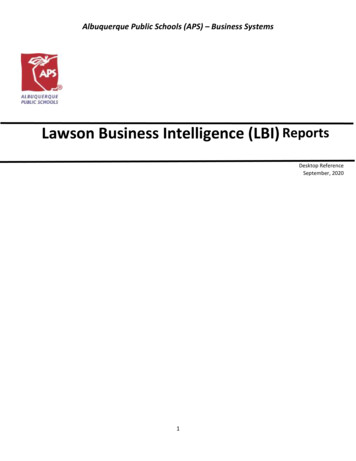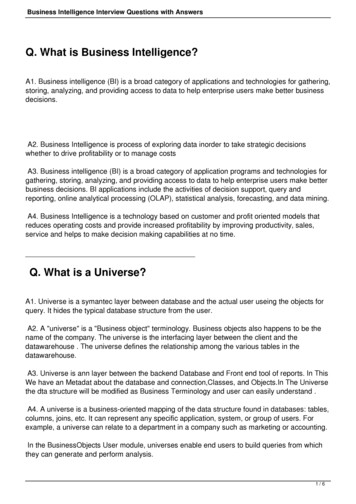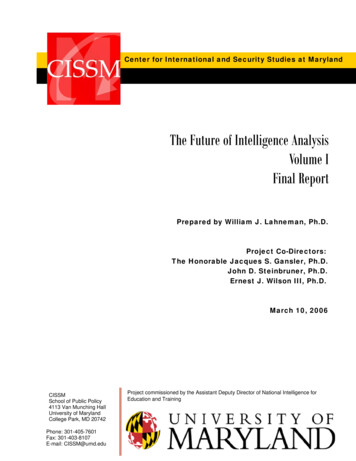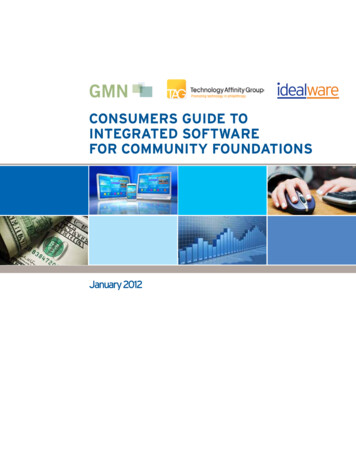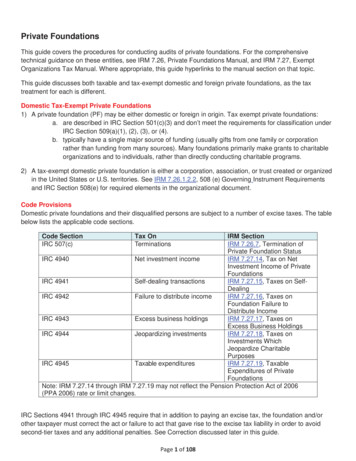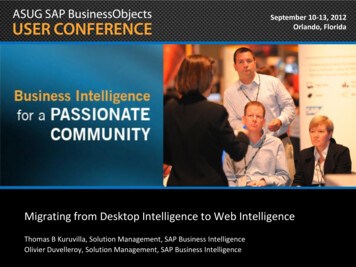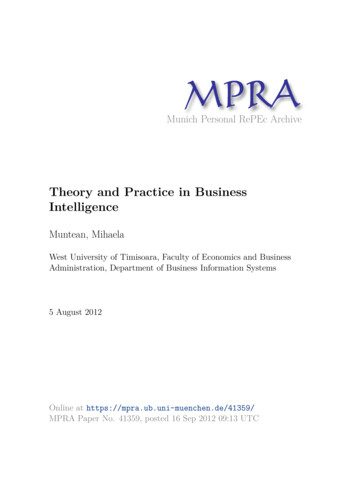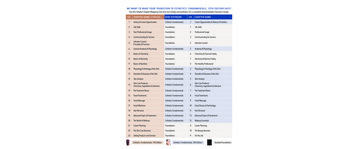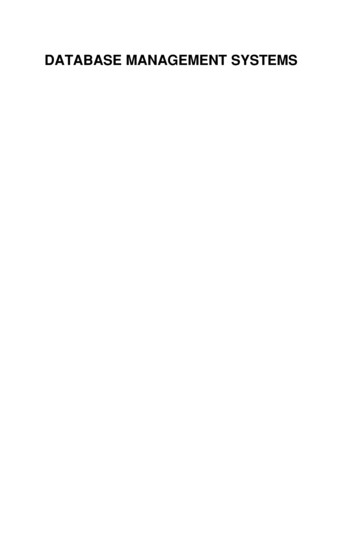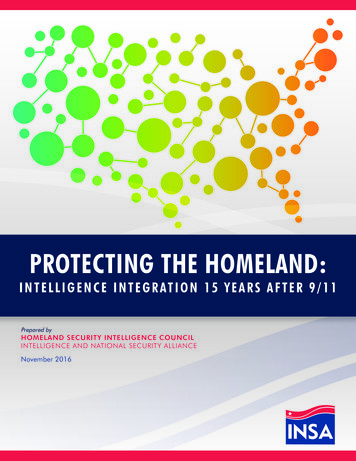
Transcription
9/15/2014Chapter 6Foundations of BusinessIntelligence: Databases andInformation ManagementVIDEO CASESCase 1a: City of Dubuque Uses Cloud Computing and Sensors to Build a Smarter,Sustainable CityCase 1b: IBM Smarter City: Portland, OregonCase 2: Data Warehousing at REI: Understanding the CustomerCase 3: Maruti Suzuki Business Intelligence and Enterprise DatabasesLearning Objectives Describe how the problems of managing data resources in atraditional file environment are solved by a databasemanagement system. Describe the capabilities and value of a databasemanagement system. Apply important database design principles. Evaluate tools and technologies for accessing informationfrom databases to improve business performance anddecision making. Assess the role of information policy, data administration,and data quality assurance in the management of firm’sdata resources.1
9/15/2014Banco de Credito Del Peru Banks on Better Data Management Problem: Multiple outdated systems, duplicate, inconsistentdata Solutions: Replace disparate legacy systems with singlerepository for business information SAP integrated software suite included modules forenterprise resource planning, and a data warehouse tosupport enterprise-wide tracking, reporting, and analysis Demonstrates IT’s role in successful data management Illustrates digital technology’s ability to lower costs whileimproving performanceOrganizing Data in a Traditional File Environment File organization concepts––––Database: Group of related filesFile: Group of records of same typeRecord: Group of related fieldsField: Group of characters as word(s) or number Describes an entity (person, place, thing on which westore information) Attribute: Each characteristic, or quality, describingentity– Example: Attributes DATE or GRADE belong to entity COURSE2
9/15/2014THE DATA HIERARCHYA computer system organizesdata in a hierarchy that startswith the bit, which representseither a 0 or a 1. Bits can begrouped to form a byte torepresent one character,number, or symbol. Bytes canbe grouped to form a field, andrelated fields can be grouped toform a record. Related recordscan be collected to form a file,and related files can beorganized into a database.FIGURE 6-1Organizing Data in a Traditional File Environment Problems with the traditional file environment(files maintained separately by differentdepartments)– Data redundancy: Presence of duplicate data in multiple files– Data inconsistency: Same attribute has different values– Program-data dependence: When changes in program requires changes to dataaccessed by program– Lack of flexibility– Poor security– Lack of data sharing and availability3
9/15/2014TRADITIONAL FILE PROCESSINGThe use of a traditionalapproach to file processingencourages each functionalarea in a corporation todevelop specializedapplications. Eachapplication requires aunique data file that islikely to be a subset of themaster file. These subsetsof the master file lead todata redundancy andinconsistency, processinginflexibility, and wastedstorage resources.FIGURE 6-2The Database Approach to Data Management Database– Serves many applications by centralizing data andcontrolling redundant data Database management system (DBMS)– Interfaces between applications and physical data files– Separates logical and physical views of data– Solves problems of traditional file environment Controls redundancyEliminates inconsistencyUncouples programs and dataEnables organization to central manage data and data security4
9/15/2014HUMAN RESOURCES DATABASE WITH MULTIPLE VIEWSFIGURE 6-3A single human resources database provides many different views of data, depending on the informationrequirements of the user. Illustrated here are two possible views, one of interest to a benefits specialist and oneof interest to a member of the company’s payroll department.The Database Approach to Data Management Relational DBMS– Represent data as two-dimensional tables– Each table contains data on entity and attributes Table: grid of columns and rows– Rows (tuples): Records for different entities– Fields (columns): Represents attribute for entity– Key field: Field used to uniquely identify each record– Primary key: Field in table used for key fields– Foreign key: Primary key used in second table as look-up field toidentify records from original table5
9/15/2014Relational Database TablesA relational database organizesdata in the form of twodimensional tables. Illustratedhere are tables for the entitiesSUPPLIER and PART showinghow they represent each entityand its attributes. SupplierNumber is a primary key forthe SUPPLIER table and aforeign key for the PART table.FIGURE 6-4The Database Approach to Data Management Operations of a Relational DBMS– Three basic operations used to develop usefulsets of data SELECT: Creates subset of data of all records thatmeet stated criteria JOIN: Combines relational tables to provide userwith more information than available in individualtables PROJECT: Creates subset of columns in table,creating tables with only the information specified6
9/15/2014THE THREE BASIC OPERATIONS OF A RELATIONAL DBMSFIGURE 6-5The select, join, and project operations enable data from two different tables to be combined and only selectedattributes to be displayed.The Database Approach to Data Management Non-relational databases: “NoSQL”––––More flexible data modelData sets stored across distributed machinesEasier to scaleHandle large volumes of unstructured and structureddata (Web, social media, graphics) Databases in the cloud– Typically, less functionality than on-premises DBs– Amazon Relational Database Service, Microsoft SQLAzure– Private clouds7
9/15/2014The Database Approach to Data Management Capabilities of database management systems– Data definition capability: Specifies structure of databasecontent, used to create tables and define characteristics offields– Data dictionary: Automated or manual file storing definitionsof data elements and their characteristics– Data manipulation language: Used to add, change, delete,retrieve data from database Structured Query Language (SQL) Microsoft Access user tools for generating SQL– Many DBMS have report generation capabilities for creatingpolished reports (Crystal Reports)MICROSOFT ACCESS DATA DICTIONARY FEATURESFIGURE 6-6Microsoft Access has a rudimentary data dictionary capability that displays information about the size, format,and other characteristics of each field in a database. Displayed here is the information maintained in theSUPPLIER table. The small key icon to the left of Supplier Number indicates that it is a key field.8
9/15/2014EXAMPLE OF AN SQL QUERYFIGURE 6-7Illustrated here are the SQL statements for a query to select suppliers for parts 137 or 150. They produce a listwith the same results as Figure 6-5.AN ACCESS QUERYFIGURE 6-8Illustrated here is how the query in Figure 6-7 would be constructed using Microsoft Access query buildingtools. It shows the tables, fields, and selection criteria used for the query.9
9/15/2014The Database Approach to Data Management Designing Databases– Conceptual (logical) design: abstract model from business perspective– Physical design: How database is arranged on direct-access storagedevices Design process identifies:– Relationships among data elements, redundant database elements– Most efficient way to group data elements to meet businessrequirements, needs of application programs Normalization– Streamlining complex groupings of data to minimize redundant dataelements and awkward many-to-many relationshipsAN UNNORMALIZED RELATION FOR ORDERFIGURE 6-9An unnormalized relation contains repeating groups. For example, there can be many parts and suppliers foreach order. There is only a one-to-one correspondence between Order Number and Order Date.10
9/15/2014NORMALIZED TABLES CREATED FROM ORDERFIGURE 6-10After normalization, the original relation ORDER has been broken down into four smaller relations. Therelation ORDER is left with only two attributes and the relation LINE ITEM has a combined, or concatenated,key consisting of Order Number and Part Number.The Database Approach to Data Management Referential integrity rules Used by RDMS to ensure relationships between tablesremain consistent Entity-relationship diagram– Used by database designers to document the data model– Illustrates relationships between entities– Caution: If a business doesn’t get data modelright, system won’t be able to serve businesswell11
9/15/2014AN ENTITY-RELATIONSHIP DIAGRAMFIGURE 6-11This diagram shows the relationships between the entities SUPPLIER, PART, LINE ITEM, and ORDER thatmight be used to model the database in Figure 6-10.Using Databases to Improve Business Performance and Decision Making Big data Massive sets of unstructured/semi-structured datafrom Web traffic, social media, sensors, and so on Petabytes, exabytes of data Volumes too great for typical DBMS Can reveal more patterns and anomalies12
9/15/2014Using Databases to Improve Business Performance and Decision Making Business intelligence infrastructure– Today includes an array of tools for separatesystems, and big data Contemporary tools:–––––Data warehousesData martsHadoopIn-memory computingAnalytical platformsUsing Databases to Improve Business Performance and Decision Making Data warehouse:– Stores current and historical data from many coreoperational transaction systems– Consolidates and standardizes information for use acrossenterprise, but data cannot be altered– Provides analysis and reporting tools Data marts:– Subset of data warehouse– Summarized or focused portion of data for use by specificpopulation of users– Typically focuses on single subject or line of business13
9/15/2014COMPONENTS OF A DATA WAREHOUSEA contemporary businessintelligence infrastructurefeatures capabilities andtools to manage andanalyze large quantities anddifferent types of data frommultiple sources. Easy-touse query andreporting tools for casualbusiness users and moresophisticated analyticaltoolsets for power usersare included.FIGURE 6-12Using Databases to Improve Business Performance and Decision Making Hadoop– Enables distributed parallel processing of big dataacross inexpensive computers– Key services Hadoop Distributed File System (HDFS): data storage MapReduce: breaks data into clusters for work Hbase: NoSQL database– Used by Facebook, Yahoo, NextBio14
9/15/2014Using Databases to Improve Business Performance and Decision Making In-memory computing– Used in big data analysis– Use computers main memory (RAM) for data storageto avoid delays in retrieving data from disk storage– Can reduce hours/days of processing to seconds– Requires optimized hardware Analytic platforms– High-speed platforms using both relational and nonrelational tools optimized for large datasetsUsing Databases to Improve Business Performance and Decision Making Analytical tools: Relationships, patterns,trends– Tools for consolidating, analyzing, and providingaccess to vast amounts of data to help users makebetter business decisions Multidimensional data analysis (OLAP)Data miningText miningWeb mining15
9/15/2014Using Databases to Improve Business Performance and Decision Making Online analytical processing (OLAP)– Supports multidimensional data analysis Viewing data using multiple dimensions Each aspect of information (product, pricing, cost,region, time period) is different dimension Example: How many washers sold in East in Junecompared with other regions?– OLAP enables rapid, online answers to ad hocqueriesMULTIDIMENSIONAL DATA MODEL“Data Cube” – “Turning the Cube”four dimensionsThe view that is showing isproduct versus region. If yourotate the cube 90 degrees, theface that will show productversus actual and projectedsales. If you rotate the cube 90degrees again, you will seeregion versus actual andprojected sales. Other views arepossible.In the Eastern region,what are the actualand projected sales ofour products (nuts,bolts, washers, andscrews)16
9/15/2014Using Databases to Improve Business Performance and Decision Making Data mining:– Finds hidden patterns, relationships in datasets Example: customer buying patterns– Infers rules to predict future behavior– Types of information obtainable from data mining: Associations Occurrences linked to single event Sequences Events linked over time Classification Recognizes patterns that describe group to which itembelongs Clustering Similar to classification when no groups have been defined;finds groupings within data Forecasting Uses series of existing values to forecast what other valueswill beUsing Databases to Improve Business Performance and Decision Making Text mining– Extracts key elements from large unstructured datasets Stored e-mails Call center transcripts Legal cases Patent descriptions Service reports, and so on– Sentiment analysis software Mines e-mails, blogs, social media to detect opinions17
9/15/2014Using Databases to Improve Business Performance and Decision Making Web mining– Discovery and analysis of useful patterns andinformation from Web– Understand customer behavior– Evaluate effectiveness of Web site, and so on– Web content mining Mines content of Web pages– Web structure mining Analyzes links to and from Web page– Web usage mining Mines user interaction data recorded by Web server Google Trends and Google Insights track the popularity of variouswords and phrases used in Google search queries, to learn whatpeople are interested in and what they are interested in buyingPrivacy Concerns Effective Data Mining requires large sources of data To achieve a wide spectrum of data, must link multiple data sources Linking sources leads can be problematic for privacy as follows: If thefollowing histories of a customer were linked:––––Shopping HistoryCredit HistoryBank HistoryEmployment History The users’ life story can be painted from the collected data Hiring, loan, other decision are made by data collected onindividuals.– What happens if the data is not correct? Data aggregators (data brokers) – it’s legal to buy and sellpersonal data.– Is this ethical?18
9/15/2014Big Data, Big Rewards Describe the kinds of big data collected by the organizationsdescribed in this case. List and describe the business intelligence technologiesdescribed in this case. Why did the companies described in this case need tomaintain and analyze big data? What business benefits didthey obtain? Identify three decisions that were improved by using big data. What kinds of organizations are most likely to need big datamanagement and analytical tools?Controversy Whirls Around the Consumer Product Safety Database What is the value of the CPSC database toconsumers, businesses, and the U.S. government? What problems are raised by this database? Why is itso controversial? Why is data quality an issue? Name two entities in the CPSC database anddescribe some of their attributes. When buying a crib, or other consumer product foryour family, would you use this database?19
9/15/2014Managing Data Resources Establishing an information policy– Firm’s rules, procedures, roles for sharing, managing,standardizing data– Data administration Establishes policies and procedures to manage data– Data governance Deals with policies and processes for managing availability,usability, integrity, and security of data, especially regardinggovernment regulations– Database administration Creating and maintaining databaseManaging Data Resources Ensuring data quality– More than 25% of critical data in Fortune 1000company databases are inaccurate or incomplete– Redundant data– Inconsistent data– Faulty input– Before new database in place, need to: Identify and correct faulty data Establish better routines for editing data oncedatabase in operation20
9/15/2014Managing Data Resources Data quality audit:– Structured survey of the accuracy and level ofcompleteness of the data in an information system Survey samples from data files, or Survey end users for perceptions of quality Data cleansing– Software to detect and correct data that areincorrect, incomplete, improperly formatted, orredundant– Enforces consistency among different sets of datafrom separate information systems21
9/15/2014 13 Business intelligence infrastructure –Today includes an array of tools for separate systems, and big data Contemporary tools: –Data warehouses –Data marts –Hadoop –In-memory computing –Analytical platforms Using Databases to Improve Business
